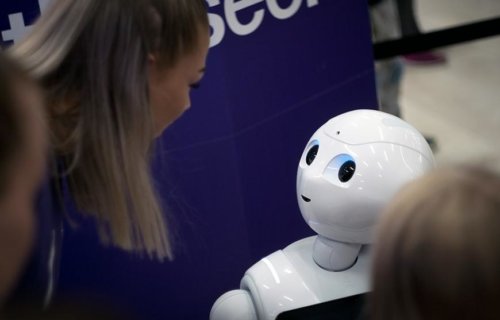TAMPERE, Finland — They say beauty is in the eye of the beholder. In the future however, that may change to “humanity is in the eye of the beholder.” A fascinating, futuristic new study finds making eye contact with a robot likely evokes the same physiological responses as locking eyes with a real person. Due to this revelation, researchers from from Tampere University are confident future interactions between humans and humanoid robots will be quite smooth.
It feels absolutely unavoidable at this point — considering recent rapid advancements in robotic technology — that people will be interacting with “social robots” more and more on a daily basis in the coming years. Robotic humanoid waiters in restaurants or perhaps an upgraded version of Amazon’s Alexa that actually looks like a person. All of that isn’t too far away.
Face-to-face with the future
Now, it’s not uncommon for people tend to place human characteristics on robots. For example, countless people have become frustrated toward home assistants when they don’t produce the answer they’re looking for. However, study authors wanted to take this line of thinking a bit further by asking what type of automatic, physiological responses do interactions with robots invoke in humans? Do our bodies react similarly to when we encounter another person?
To answer these questions, researchers analyzed physiological reactions among a group of participants as they either made direct eye contact with a humanoid robot or a real person.
To start, researchers placed volunteers face-to-face with another person or a robot. Then, the two parties either looked directly at one another or avoided making eye contact by averting their gaze. During these interactions, researchers tracked and measured participants’ skin conductance and heart rate. Both of these readings are indicative of autonomous nervous system activation, positive affective reactions, and focused attention.
Eye contact puts a smile on anyone’s face — even a robot’s!
Regardless of whether or not they were across the room from another person or a robot, all of participants’ physiological reactions were stronger when making direct eye contact as opposed to looking away. Making eye contact with both a robot or a person invoked the same responses: focused attention, arousal activation, and a positive emotional response.
“Our results indicate that the non-linguistic, interaction-regulating cues of social robots can affect humans in the same way as similar cues presented by other people. Interestingly, we respond to signals that have evolved over the course of evolution to regulate human interaction even when these signals are transmitted by robots. Such evidence allows us to anticipate that as robot technology develops, our interaction with the social robots of the future may be surprisingly seamless,” says doctoral researcher Helena Kiilavuori in a university release.
“The results were quite astonishing for us, too, because our previous results have shown that eye contact only elicits the reactions we perceived in this study when the participants know that another person is actually seeing them. For example, in a video conference, eye contact with the person on the screen does not cause these reactions if the participant knows that his or her own camera is off, and the other person is unable to see him or her. The fact that eye contact with a robot produces such reactions indicates that even though we know the robot is a lifeless machine, we treat it instinctively as if it could see us. As if it had a mind which looked at us,” concludes Professor of Psychology Jari Hietanen, director of the project.
The study is published in Biological Psychology.
